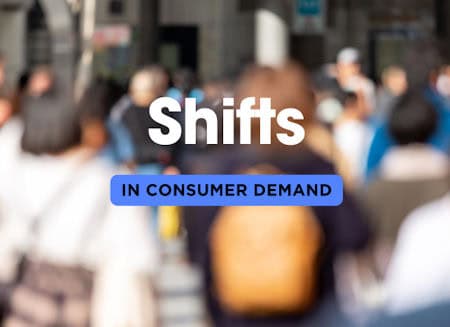Shifts in Consumer Demand and Their Impact on Maritime Shipping

Changing consumer preferences in regions like Asia, Africa, Latin America, Europe, and North America are significantly altering global shipping patterns. These shifts are driven by various factors, including economic growth, urbanization, technological adoption, sustainability concerns, and the rise of e-commerce. Here’s a detailed analysis of how these regions are impacting shipping routes and logistics:
Asia
- Rise of E-commerce: Asia, particularly China and Southeast Asia, has seen an explosive growth in e-commerce, with platforms like Alibaba, Shopee, and Lazada driving demand. This growth has shifted shipping patterns toward shorter, intra-Asia routes, reducing reliance on traditional long-haul routes to Europe and North America.
- Shift in Manufacturing Hubs: As labor costs rise in China, manufacturing is shifting to other Asian countries like Vietnam, Indonesia, and India. This shift is creating new shipping routes focused on intra-Asia trade, as well as new routes connecting these countries directly to Western markets.
- Growing Middle Class: The expanding middle class in countries like India and Indonesia is driving demand for imported goods, leading to increased shipping volumes into these regions. Ports in these countries are expanding and modernizing to handle the increased traffic.
Africa
- Infrastructure Development: Africa is witnessing significant investments in port and infrastructure development, particularly in East Africa. Countries like Kenya and Tanzania are improving their port facilities to handle increased volumes, driven by rising consumer demand and intra-African trade facilitated by the African Continental Free Trade Area (AfCFTA).
- Emergence of Consumer Markets: As consumer markets in Africa grow, there’s a rising demand for imported goods, especially in urban centers. This growth is shifting shipping routes to focus more on direct routes to African ports rather than relying on transshipment hubs in Europe or the Middle East.
- Increased Trade with Asia: Africa’s trade with Asia, particularly China and India, is increasing, leading to new shipping routes that bypass traditional European transshipment hubs. This is reducing shipping times and costs, making African markets more attractive to global suppliers.
Latin America
- Demand for Fast-Moving Consumer Goods (FMCG): In Latin America, there’s a growing demand for FMCG, driven by urbanization and an expanding middle class. This has led to a shift in shipping patterns, with increased direct shipments to Latin American ports rather than routing through the United States.
- Regional Trade Agreements: Trade agreements like the Pacific Alliance (comprising Chile, Colombia, Mexico, and Peru) are facilitating increased intra-regional trade. This is creating new shipping routes that focus on connecting these economies, bypassing traditional routes through North American ports.
- Port Modernization: Ports in Latin America, such as those in Brazil and Mexico, are undergoing modernization to handle larger vessels and increased trade volumes. This is attracting more direct shipping services, reducing the need for transshipment and improving the efficiency of supply chains in the region.
Europe
- Focus on Sustainability: European consumers are increasingly prioritizing sustainability, which is driving demand for eco-friendly products and practices. This shift is influencing shipping patterns, with companies optimizing routes to minimize carbon footprints and selecting ports with green initiatives. The European Green Deal is also pushing the industry toward more sustainable practices, which may lead to shorter, more direct routes that reduce emissions.
- High Demand for Technology and Luxury Goods: Europe remains a key market for high-end technology and luxury products. This demand influences shipping routes to prioritize efficient and secure delivery channels from manufacturing hubs in Asia, particularly China and South Korea, to major European cities.
- Shifts in Intra-European Trade: With the expansion of the European Union and increasing regional trade agreements, there is a growing emphasis on intra-European shipping routes. This is leading to a decrease in reliance on transcontinental routes and an increase in the frequency of shorter, regional routes.
North America
- Boom in E-commerce: The e-commerce boom in North America, particularly in the United States, has reshaped shipping routes. The demand for faster delivery times has led to a focus on direct shipping routes from Asian manufacturing hubs to key U.S. ports, bypassing traditional stopovers in Europe.
- Infrastructure and Port Modernization: In response to increasing trade volumes, North American ports, particularly in the U.S. and Canada, are undergoing significant modernization. This includes expanding port capacities and enhancing logistics infrastructure, which is leading to more efficient shipping routes that can handle larger vessels and increased traffic.
- Shifts in Energy and Resource Shipping: With North America’s growing emphasis on energy independence and the development of natural resources, there is a shift in shipping routes to accommodate the export of oil, gas, and other natural resources from the U.S. and Canada to global markets. This includes new routes to Asia and Europe that bypass traditional Middle Eastern and African routes.
Key Impacts on Global Shipping Patterns
- Shorter Shipping Routes: The rise of regional trade and manufacturing hubs in Asia, Africa, and Latin America is leading to shorter shipping routes. This trend is reducing the reliance on long-haul routes and transshipment hubs, as goods are increasingly shipped directly between emerging markets.
- Increased Intra-Regional Trade: As regional consumer markets grow, there’s an increased focus on intra-regional trade. This shift is creating new shipping routes that are more cost-effective and time-efficient, benefiting both shippers and consumers.
- Port Development and Modernization: The growth in consumer demand is driving significant investments in port infrastructure across these regions. Modernized ports with better facilities are attracting more direct shipping services, further altering traditional shipping patterns.
These regional shifts in consumer demand are not just altering existing shipping routes but also creating new opportunities for shipping companies to optimize their operations, reduce costs, and tap into growing consumer markets.
| ShipUniverse: Regional Consumer Demand Trends and Corresponding Shipping Route Adjustments | ||
|---|---|---|
| Region | Shifting Consumer Demand | Shipping Route Adjustments |
| Asia |
– Explosive growth in e-commerce, particularly in China and Southeast Asia. – Shift in manufacturing hubs from China to Vietnam, Indonesia, and India. – Expanding middle class driving increased demand for imported goods. |
– Increased intra-Asia routes to accommodate shorter, regional shipping demands. – New direct shipping routes from Vietnam, Indonesia, and India to Western markets. – Expansion of port facilities in India and Southeast Asia to handle increased volumes. |
| Africa |
– Growing consumer markets, especially in urban centers. – Rising demand for imported goods and increased intra-African trade. – Significant investments in port infrastructure and development. |
– Emergence of new direct shipping routes to African ports, reducing reliance on European transshipment hubs. – Development of intra-African shipping routes facilitated by the African Continental Free Trade Area (AfCFTA). – Expansion and modernization of ports in East Africa, such as in Kenya and Tanzania. |
| Latin America |
– Increasing demand for Fast-Moving Consumer Goods (FMCG) driven by urbanization. – Growth in intra-regional trade due to trade agreements like the Pacific Alliance. – Port modernization efforts in key countries like Brazil and Mexico. |
– Increased direct shipping routes to Latin American ports, bypassing U.S. transshipment points. – Development of new shipping routes connecting Pacific Alliance countries. – Ports in Brazil and Mexico attracting more direct shipping services due to modernization. |
| Europe |
– Stable but mature consumer markets with a shift toward sustainable and eco-friendly products. – Increasing demand for high-tech and luxury goods from Asia. – Consumer preference for locally sourced products. |
– Continued reliance on established long-haul routes but with an emphasis on sustainability. – Growing focus on shipping routes that minimize environmental impact. – Enhanced logistics to support the import of high-tech goods from Asia. |
| North America |
– Strong demand for consumer electronics and e-commerce goods. – Increased demand for faster delivery times, particularly in urban centers. – Rising interest in sustainably sourced and eco-friendly products. |
– Optimization of shipping routes for speed, with a focus on direct services to major U.S. ports. – Enhanced logistics and last-mile delivery systems to meet consumer expectations. – Adjustments in supply chains to accommodate the import of sustainable products. |
Changes in Seasonal Demand and Their Effect on Shipping Routes
Seasonal consumer demand plays a significant role in shaping global shipping operations. These shifts in demand are driven by factors such as holidays, weather conditions, agricultural cycles, and regional festivals, all of which can lead to variations in the timing and routes of shipping operations. Here’s how these seasonal changes influence global shipping routes:
1. Holiday Seasons and Peak Shipping Periods
- Impact on Shipping Volumes: During major holiday seasons, such as Christmas, Lunar New Year, and Diwali, there is a substantial increase in consumer demand for goods. Retailers worldwide stock up on products well in advance, leading to a spike in shipping volumes. This often results in congestion at key ports, especially those in Asia, which are central to global supply chains.
- Adjustments in Shipping Routes: To meet the surge in demand, shipping companies may reroute vessels to less congested ports or increase the frequency of sailings on certain routes. For example, during the Christmas season, there is typically a higher demand for goods transported from East Asia to North America and Europe, prompting adjustments to ensure timely deliveries.
2. Agricultural Cycles and Fresh Produce Shipping
- Timing of Shipments: Agricultural cycles heavily influence the timing of shipments, particularly for fresh produce. Different crops have specific harvest seasons, and the global demand for fresh fruits and vegetables means that shipping routes are adjusted to align with these periods. For example, during the Northern Hemisphere’s winter, there is an increased demand for fresh produce from countries in the Southern Hemisphere, such as Chile and South Africa.
- Seasonal Route Changes: Shipping routes may shift to prioritize access to regions producing in-season goods. For instance, shipping companies might focus more on routes from South America to North America and Europe during their respective winter months to meet the demand for fresh produce.
3. Weather Conditions and Seasonal Variability
- Impact of Weather on Shipping Routes: Seasonal weather conditions, such as monsoons, hurricanes, and ice, can drastically impact shipping routes. For instance, the monsoon season in the Indian Ocean can cause delays and force ships to take longer, safer routes. Similarly, during the winter months, routes through the Northern Sea may become impassable due to ice, requiring alternative routing through the Suez or Panama Canals.
- Route Adjustments for Safety and Efficiency: To avoid delays and potential hazards, shipping companies often adjust routes based on seasonal weather forecasts. This can include rerouting vessels to avoid storm-prone areas or utilizing icebreaker-assisted routes in polar regions during the warmer months.
4. Regional Festivals and Market Demand
- Increased Demand Around Festivals: Regional festivals, such as the Lunar New Year in China, Eid in the Middle East, and Thanksgiving in the United States, lead to spikes in demand for certain goods. These festivals often require shipping companies to plan ahead and adjust their operations to ensure that goods arrive on time.
- Strategic Route Planning: To accommodate these demand spikes, shipping companies may prioritize certain routes, increase the number of vessels on those routes, or charter additional capacity. For example, during the Lunar New Year, there is a rush to ship goods out of China before factories shut down, leading to a significant increase in outbound shipments.
5. Retail Sales Events
- Black Friday and Cyber Monday: Major sales events like Black Friday and Cyber Monday in the United States lead to a surge in online orders and, consequently, in shipping volumes. Shipping companies must adjust their routes and schedules to handle the increased load, often resulting in more frequent sailings and the use of faster, direct routes.
- Adjustments to Meet Tight Deadlines: Retailers and consumers expect timely deliveries during these sales events, which forces shipping companies to optimize routes and minimize delays. This may involve prioritizing certain shipments over others or temporarily altering the shipping schedule to meet tight deadlines.
The shifts in seasonal consumer demand have a profound effect on global shipping operations. By understanding these patterns and adjusting routes accordingly, shipping companies can optimize their operations to meet the fluctuating demands of different seasons. This not only ensures timely deliveries but also enhances efficiency and customer satisfaction in an increasingly competitive global market.
| ShipUniverse: Seasonal Variations in Consumer Demand and Shipping Route Adaptations | ||
|---|---|---|
| Season | Consumer Demand Trends | Shipping Route Adaptations |
| Winter (Northern Hemisphere) |
– Increased demand for fresh produce from Southern Hemisphere regions. – Surge in consumer electronics purchases during holiday seasons. – High demand for warm clothing and winter goods in North America and Europe. |
– Shipping routes shift towards Southern Hemisphere producers, e.g., from South America to North America and Europe. – Increased frequency of shipments from East Asia to North America and Europe to meet holiday demand. – Prioritization of shipping routes that avoid ice-prone regions. |
| Spring (Northern Hemisphere) |
– Demand for agricultural equipment and seeds in preparation for planting seasons. – Increase in consumer demand for home improvement and gardening products. – Early demand for summer-related products like apparel and outdoor gear. |
– Adjustments to shipping routes to accommodate increased imports of agricultural products and equipment. – Focus on shipping routes from Asia to North America and Europe for early summer products. – Optimization of shipping schedules to ensure timely delivery of seasonal goods. |
| Summer (Northern Hemisphere) |
– Peak demand for fresh fruits and vegetables from local and global sources. – Increase in tourism-related goods such as travel gear and summer apparel. – High demand for building materials and construction supplies. |
– Shipping routes prioritize regions with high production of summer crops, e.g., North America and Europe. – Increased frequency of shipments to tourist destinations and regions with high summer activity. – Focus on efficient delivery routes for construction materials to meet building season demands. |
| Fall (Northern Hemisphere) |
– Demand for harvest-related equipment and machinery. – Rise in demand for fall fashion, school supplies, and electronics. – Preparations for winter holidays leading to early stocking of goods. |
– Routes adjusted to support the agricultural sector, focusing on regions producing fall harvests. – Increased shipments from Asia to Western markets for fall and back-to-school products. – Early adjustments to shipping routes to handle pre-holiday stocking demands. |
| Holiday Seasons (Various Regions) |
– Massive spike in demand for consumer goods, particularly electronics, toys, and clothing. – Regional spikes during specific holidays, e.g., Diwali in India, Lunar New Year in China, Christmas in the West. |
– Significant rerouting to prioritize fast and direct shipping routes to major markets. – Increased chartering of additional vessels and utilization of alternative ports to handle peak volumes. – Strategic planning to avoid port congestion and ensure timely delivery. |
The Influence of Demographic Changes on Shipping Patterns
Demographic changes across the globe are having a profound impact on shipping patterns. Factors such as aging populations, urbanization, and shifts in consumer behavior due to demographic transitions are influencing the flow of goods and necessitating adjustments in shipping routes. These changes are not only altering where goods are shipped but also how frequently and in what quantities. Here’s an exploration of these influences:
1. Aging Populations and Their Impact on Shipping
- Increased Demand for Healthcare and Medical Supplies: As populations in regions like Europe, Japan, and North America age, there is a growing demand for healthcare-related products, including pharmaceuticals, medical equipment, and mobility aids. This has led to more specialized shipping routes that prioritize the timely and secure transportation of these goods.
- Shift in Consumer Goods Demand: Aging populations tend to have different consumption patterns compared to younger demographics. There is often a shift from fast-moving consumer goods (FMCG) and luxury items to products that cater to health, wellness, and home care. This change influences shipping routes, with more goods being shipped from regions that produce these specialized items, such as advanced economies in Europe and North America.
- Impact on Labor Force and Logistics: An aging population can also lead to a shrinking labor force, which affects the logistics sector. In regions with significant aging populations, there may be a need to optimize shipping routes to account for reduced human resources in logistics and port operations, potentially increasing reliance on automation and technology-driven logistics solutions.
2. Urbanization and Its Effects on Shipping Patterns
- Concentration of Demand in Urban Centers: As more people move into cities, there is a growing concentration of consumer demand in urban areas. This urbanization trend, particularly strong in Asia and Africa, is driving changes in shipping routes, with a focus on direct deliveries to mega-cities and large metropolitan areas.
- Increased Demand for Construction Materials: Rapid urbanization fuels the demand for construction materials, from steel and cement to advanced building technologies. This has led to the development of specialized shipping routes that cater to the construction industry, often focusing on delivering goods to ports that serve major urban centers.
- Expansion of E-commerce: Urban populations are also driving the expansion of e-commerce, particularly in Asia. The demand for fast and reliable delivery services is altering shipping routes, with an increase in shorter, more frequent shipments to meet the needs of urban consumers. This often involves optimizing last-mile delivery networks and using regional distribution hubs.
3. Shifts in Consumer Behavior Due to Demographic Changes
- Changing Dietary Preferences: As populations become more health-conscious, there is a growing demand for fresh, organic, and locally-sourced food products. This shift is impacting shipping routes, with more goods being transported from regions that produce these types of foods, including organic farming areas in Europe, North America, and Australia.
- Rise of the Experience Economy: Younger demographics, particularly in urban areas, are increasingly prioritizing experiences over goods. This trend is reducing the demand for certain consumer products while increasing the need for goods related to travel, leisure, and hospitality. Shipping routes are adapting by focusing more on transporting goods that support the experience economy, such as high-end electronics, travel gear, and specialty foods.
- Sustainability and Ethical Consumption: Demographic shifts are also leading to changes in consumer values, with a growing emphasis on sustainability and ethical consumption. This is influencing shipping routes, as companies seek to minimize their environmental impact by choosing more direct routes, reducing the carbon footprint of their logistics operations, and selecting ports that are closer to their final destinations.
Key Takeaways
- Adaptation to Demographic Changes: Shipping companies must continually adapt their routes and operations to meet the evolving demands driven by demographic changes. This includes adjusting routes to accommodate the increased demand for healthcare products in aging populations, optimizing shipping to urban centers experiencing rapid growth, and aligning with shifts in consumer behavior.
- Opportunities for Innovation: Demographic shifts present opportunities for innovation in the shipping industry. Companies that can anticipate and adapt to these changes are better positioned to capture market share, particularly in emerging urban markets and regions with aging populations.
- Focus on Sustainability: As consumer preferences shift towards sustainability, shipping companies will need to focus on optimizing their routes and operations to reduce their environmental impact. This includes choosing the most efficient routes, investing in greener technologies, and prioritizing sustainability in their logistics strategies.
Understanding and adapting to these demographic changes will be crucial for shipping companies looking to remain competitive in a rapidly changing global market. The ability to anticipate shifts in consumer demand and adjust shipping routes accordingly will be a key factor in ensuring timely and efficient delivery of goods in the future.
| ShipUniverse: Ways Consumer Demand Can Shift Shipping Routes | |||
|---|---|---|---|
| Factor | Impact on Shipping Routes (High, Medium, Low) | Regions Most Affected | Examples of Route Adjustments |
| Holiday Seasons | High | Global, especially North America, Europe, East Asia |
– Increased frequency of shipments from East Asia to Western markets. – Utilization of alternative ports to avoid congestion. – Temporary route prioritization for faster deliveries. |
| Aging Populations | Medium | Europe, Japan, North America |
– Specialized shipping routes for medical supplies and healthcare products. – Reduced frequency of luxury goods shipments. – Adjustments in logistics to account for reduced labor force. |
| Urbanization | High | Asia, Africa, Latin America |
– Focus on direct routes to mega-cities and urban centers. – Increased shipments of construction materials to support urban growth. – Optimization of last-mile delivery networks in urban areas. |
| Shifts in Consumer Preferences | Medium | Global, with variations by region |
– Increase in routes for sustainable and organic products from specific regions. – Reduction in routes for declining product categories (e.g., CDs, DVDs). – Development of new routes to cater to niche markets and products. |
| E-commerce Growth | High | Asia, North America, Europe |
– Creation of new, shorter shipping routes to meet fast delivery expectations. – Increased focus on direct shipping to distribution centers. – Adjustment of routes to handle higher frequency of small shipments. |
| Seasonal Agricultural Demand | High | Global, with seasonal variations |
– Route adjustments to prioritize regions with in-season agricultural production. – Increased frequency of shipments from the Southern Hemisphere during winter in the Northern Hemisphere. – Focus on refrigerated shipping routes for perishable goods. |
| Weather Conditions | Medium | Global, particularly in storm-prone regions |
– Seasonal rerouting to avoid monsoon or hurricane-prone areas. – Use of alternative routes during icy conditions in polar regions. – Adjustment of shipping schedules to account for potential delays. |
| Sustainability and Ethical Consumption | Medium | Europe, North America, Asia |
– Preference for routes that minimize carbon footprint. – Increased use of eco-friendly ports and facilities. – Adjustment of shipping practices to align with consumer demand for ethically sourced products. |
As the global shipping industry continues to evolve, it is clear that demographic changes, consumer demand shifts, and seasonal variations play a pivotal role in shaping shipping routes. Understanding these dynamics is essential for shipping companies and fleet owners looking to optimize their operations and stay competitive in a rapidly changing market. From aging populations driving demand for healthcare supplies to urbanization concentrating consumer needs in mega-cities, each factor requires careful consideration and strategic planning.
By staying attuned to these trends and adapting shipping routes accordingly, industry players can ensure that they meet consumer demands efficiently, reduce costs, and contribute to a more sustainable global supply chain. The future of shipping will undoubtedly be influenced by these demographic and consumer-driven changes, making it more important than ever to stay informed and adaptable.

Do you have any feedback or additional insights? Please reach out to editor @ shipuniverse.com


